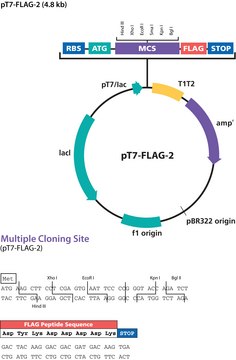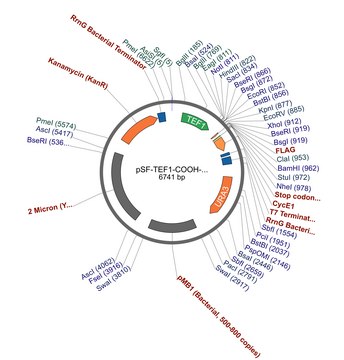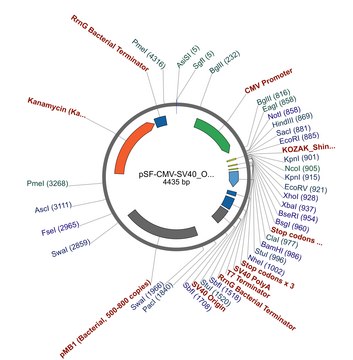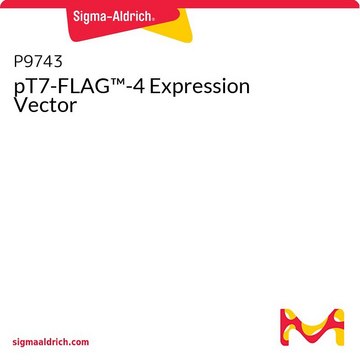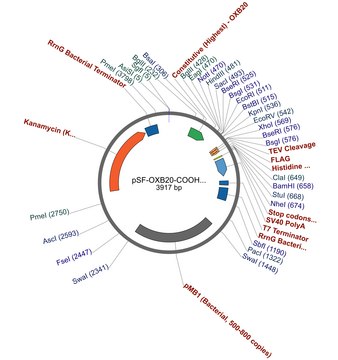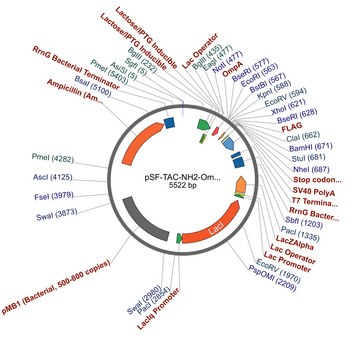推荐产品
标签
FLAG® tagged
表单
buffered aqueous solution
分子量
size 6195 bp
菌种筛选
kanamycin
哺乳动物细胞筛选
puromycin
复制起点
pUC (500 copies)
肽切割
TEV
肽标签位置
C-terminal
启动子
Promoter name: CMV
Promoter activity: constitutive
Promoter type: mammalian
报告基因
none
运输
ambient
储存温度
−20°C
一般描述
This plasmid is designed to express tagged proteins in mammalian cells either by transient transfection or by creating stable cell lines. It contains a puromycin resistance expression cassette using the human Ubiquitin promoter to drive expression and allow for the selection of cells containing the plasmid.
About the Peptide Tag:This plasmid contains a c-terminal Flag epitope tag that can be fused to a gene of interest to allow protein detection and/or purification. The sequence of the tag is: DYKDDDDK.
About the Cleavage Tag:This plasmid also encodes a protease cleavage site that is designed to be positioned between your gene of interest and the tag to allow the removal of the tag following protein purification or isolation. This plasmid contains a TEV cleavage tag. The protein sequence of the cleavage tag is: ENLYFQG. Cleavage occurs between the Glu and Gly residues. TEV is often reported to have better specificity for its recognition site compared to EKT Thrombin or Faxtor Xa.
Promoter Expression Level: This plasmid contains the mammalian CMV promoter to drive gene expression. We have tested all of our mammalian promoters in a range of cell types and CMV is consistently the strongest in those we have studied. However there are many reports of the CMV promoter demonstrating silencing by methylation in long-term culture.
About the Peptide Tag:This plasmid contains a c-terminal Flag epitope tag that can be fused to a gene of interest to allow protein detection and/or purification. The sequence of the tag is: DYKDDDDK.
About the Cleavage Tag:This plasmid also encodes a protease cleavage site that is designed to be positioned between your gene of interest and the tag to allow the removal of the tag following protein purification or isolation. This plasmid contains a TEV cleavage tag. The protein sequence of the cleavage tag is: ENLYFQG. Cleavage occurs between the Glu and Gly residues. TEV is often reported to have better specificity for its recognition site compared to EKT Thrombin or Faxtor Xa.
Promoter Expression Level: This plasmid contains the mammalian CMV promoter to drive gene expression. We have tested all of our mammalian promoters in a range of cell types and CMV is consistently the strongest in those we have studied. However there are many reports of the CMV promoter demonstrating silencing by methylation in long-term culture.
序列
To view sequence information for this product, please visit the product page
分析说明
To view the Certificate of Analysis for this product, please visit www.oxgene.com
法律信息
FLAG is a registered trademark of Merck KGaA, Darmstadt, Germany
相关产品
产品编号
说明
价格
储存分类代码
12 - Non Combustible Liquids
闪点(°F)
Not applicable
闪点(°C)
Not applicable
法规信息
新产品
Tomomi Yamamoto-Fukuda et al.
European archives of oto-rhino-laryngology : official journal of the European Federation of Oto-Rhino-Laryngological Societies (EUFOS) : affiliated with the German Society for Oto-Rhino-Laryngology - Head and Neck Surgery, 272(10), 2689-2696 (2014-08-21)
We reported previously that keratinocyte growth factor (KGF), a mesenchymal cell-derived paracrine growth factor, plays an important role in middle ear cholesteatoma formation, which is characterized by marked proliferation of epithelial cells. Here, we investigated whether KGF, the main factor
Diana Romero et al.
Carcinogenesis, 37(1), 18-29 (2015-10-28)
Dickkopf-3 (Dkk-3) is a secreted protein whose expression is downregulated in many types of cancer. Endogenous Dkk-3 is required for formation of acini in 3D cultures of prostate epithelial cells, where it inhibits transforming growth factor (TGF)-β/Smad signaling. Here, we
Geoffrey M Lynn et al.
Nature biotechnology, 33(11), 1201-1210 (2015-10-27)
The efficacy of vaccine adjuvants such as Toll-like receptor agonists (TLRa) can be improved through formulation and delivery approaches. Here, we attached small molecule TLR-7/8a to polymer scaffolds (polymer-TLR-7/8a) and evaluated how different physicochemical properties of the TLR-7/8a and polymer
Jin-Gyoung Jung et al.
PLoS genetics, 10(10), e1004751-e1004751 (2014-10-31)
The Notch3 signaling pathway is thought to play a critical role in cancer development, as evidenced by the Notch3 amplification and rearrangement observed in human cancers. However, the molecular mechanism by which Notch3 signaling contributes to tumorigenesis is largely unknown.
Alexander C Cerny et al.
PLoS genetics, 11(10), e1005578-e1005578 (2015-10-29)
Recycling of signaling proteins is a common phenomenon in diverse signaling pathways. In photoreceptors of Drosophila, light absorption by rhodopsin triggers a phospholipase Cβ-mediated opening of the ion channels transient receptor potential (TRP) and TRP-like (TRPL) and generates the visual
我们的科学家团队拥有各种研究领域经验,包括生命科学、材料科学、化学合成、色谱、分析及许多其他领域.
联系技术服务部门
